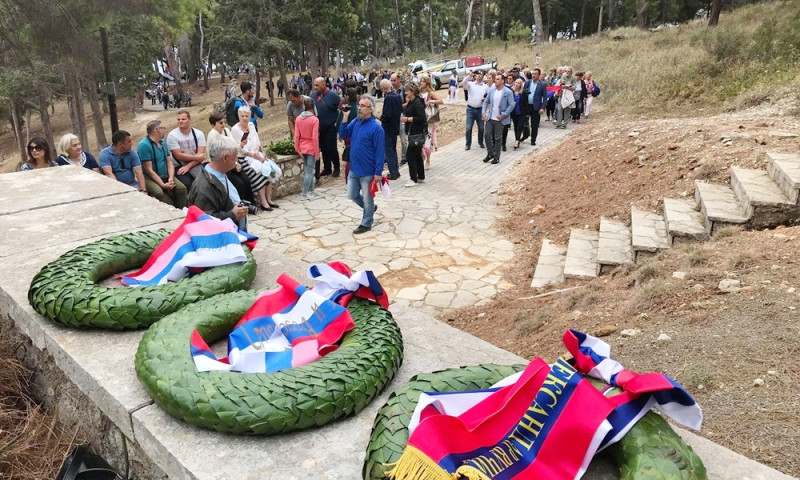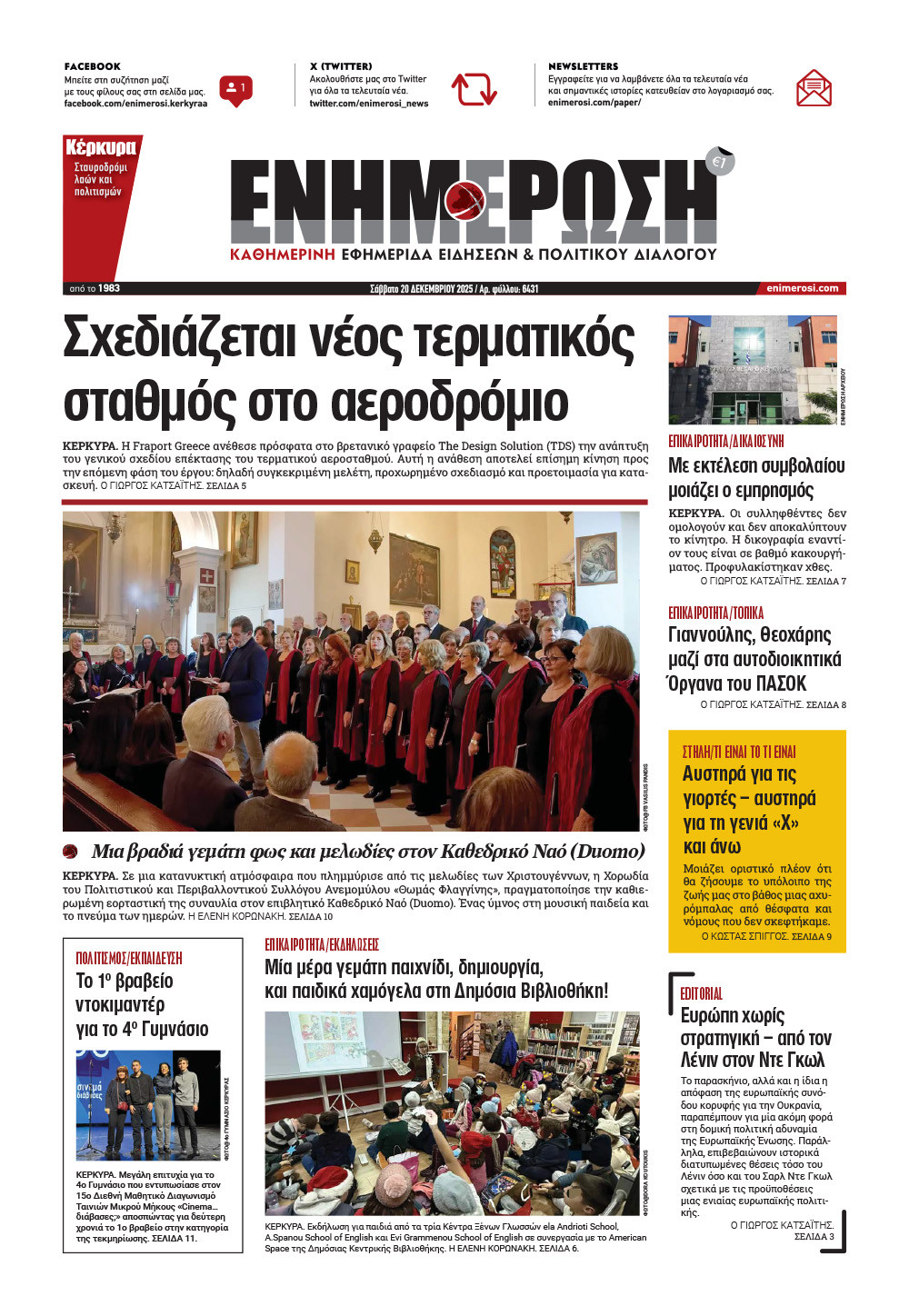Visit to the Serbian Mausoleum on Vidos - Culmination of the 2-day memorial events

Serbia
28 Sep 2018
/ 09:13
CORFU. Today is the high point of the memorial events held in remembrance of the Serbs who lost their lives in the First World War while the Serbian Army was stationed in Corfu (1916-18).
The traditional visit to the Serbian Mausoleum on Vidos took place this morning with the Serbian delegation led by Nikola Selakovic, Presidency Secretary and the President's special emissary and Zoran Djordjevic, Minister for Labour, Employment, Veteran and Social Affairs.
Yesterday morning a delegation led by Negovan Stancovic, Deputy Minister for Labour, Employment, Veteran and Social Affairs along with local representatives attended events in Gouvia and Ag. Mathaio at monuments there, including the Yiannis Yiannoulis monument.
Earlier this week the Serbian Ambassador to Greece Dusan Spasojevic, Consul Milan Vukosavljevic and the honorary Consul for Corfu Spyros Mastoras paid a courtesy visit to the Mayor of Corfu Kostas Nikolouzos and Regional Governor Theodoros Galiatsatos at the Old Town Hall, as did a delegation of Serbian Veterans. The twinning of Ionian Islands with Vojvodina in Serbia was discussed as well as the special relationship of Serbia with the Ionian on a cultural, trade and tourist level. Dusan Spasojevic invited Mr. Galiatsatos to the 41st Tourism Exhibition in Belgrade in February '19. The Regional Chief of Police Ioannis Matsoukas was also present.

The historical roles of Gouvia and Ai Matthias
It is estimated that between January and April 1916 approximately 150,000 Serbians - civilians and what remained of the Serbian Army - came to Corfu. They landed in Gouvia Bay, where the first of the memorial events took place, with Allied vessels from Durres and, mainly, Avlonas. The first account of the tragedy is written in three languages (Greek, Serbian and English) on the monument which ws erected in their memory - "In this harbour on the Island of Corfu the Serbian Allied Army landed from 6 January to 5 April 1916, coming from Albania"
Yesterday morning a delegation led by Negovan Stancovic, Deputy Minister for Labour, Employment, Veteran and Social Affairs along with local representatives attended events in Gouvia and Ag. Mathaio at monuments there, including the Yiannis Yiannoulis monument.
Earlier this week the Serbian Ambassador to Greece Dusan Spasojevic, Consul Milan Vukosavljevic and the honorary Consul for Corfu Spyros Mastoras paid a courtesy visit to the Mayor of Corfu Kostas Nikolouzos and Regional Governor Theodoros Galiatsatos at the Old Town Hall, as did a delegation of Serbian Veterans. The twinning of Ionian Islands with Vojvodina in Serbia was discussed as well as the special relationship of Serbia with the Ionian on a cultural, trade and tourist level. Dusan Spasojevic invited Mr. Galiatsatos to the 41st Tourism Exhibition in Belgrade in February '19. The Regional Chief of Police Ioannis Matsoukas was also present.

The historical roles of Gouvia and Ai Matthias
It is estimated that between January and April 1916 approximately 150,000 Serbians - civilians and what remained of the Serbian Army - came to Corfu. They landed in Gouvia Bay, where the first of the memorial events took place, with Allied vessels from Durres and, mainly, Avlonas. The first account of the tragedy is written in three languages (Greek, Serbian and English) on the monument which ws erected in their memory - "In this harbour on the Island of Corfu the Serbian Allied Army landed from 6 January to 5 April 1916, coming from Albania"
It was in Gouvia that the first temporary accommodation was established - aided by the French and British allies. Later (April and May) a large number of Serbian soldiers left from Gouvia Bay to continue fighting on the Macedonian Front (There are photos showing the soldiers embarking on carriers from the 16th Regiment of the Morava Division).
Ai Mathaios (where the second event was held) was one of the following key 'settlements' in Corfu. Together with Ipsos, Kato Korakiana, Strogili and Vraganiotika it was one of the main camps for the Serbian Army (The Army and political headquarters were in the town).
Near the army camp at Ai Mathaios was the largest of the 28 main cemetries (there were several others throughout the island) for the 5,000 young soldiers and the total of 10,000 Serbs who were defeated by the hardships. It is estimated that there are 520 graves (plus 500 in Katomeri) and a memorial was later erected in Ai Mathaios.
There are those two monuments plus the main one on Vidos Island.

Ioannis Yiannoulis
He is collectively remembered as one of the locals who played a major role in the Corfu humanitarian support of the Serbs in 1916 (along with the manufacturer Miltiadis Margaritis and the doctors Konstantinos Palatianos and Spyridon Paxinos). Yiannoulis was a simple farmer from Ai Mathaios who gave his land for the burial of the Serbian soldiers despite the fact that his crops were his only source of income. What is especially remarkable is that even when the bodies were transferred to the Mausoleum on Vidos in 1939 he still refused to grow anything on the land!
Ai Mathaios (where the second event was held) was one of the following key 'settlements' in Corfu. Together with Ipsos, Kato Korakiana, Strogili and Vraganiotika it was one of the main camps for the Serbian Army (The Army and political headquarters were in the town).
Near the army camp at Ai Mathaios was the largest of the 28 main cemetries (there were several others throughout the island) for the 5,000 young soldiers and the total of 10,000 Serbs who were defeated by the hardships. It is estimated that there are 520 graves (plus 500 in Katomeri) and a memorial was later erected in Ai Mathaios.
There are those two monuments plus the main one on Vidos Island.

Ioannis Yiannoulis
He is collectively remembered as one of the locals who played a major role in the Corfu humanitarian support of the Serbs in 1916 (along with the manufacturer Miltiadis Margaritis and the doctors Konstantinos Palatianos and Spyridon Paxinos). Yiannoulis was a simple farmer from Ai Mathaios who gave his land for the burial of the Serbian soldiers despite the fact that his crops were his only source of income. What is especially remarkable is that even when the bodies were transferred to the Mausoleum on Vidos in 1939 he still refused to grow anything on the land!












